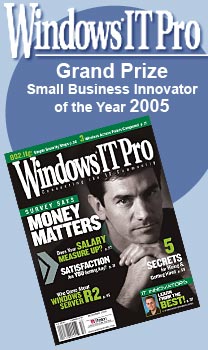 |
||||
  |
    |
|||
|
||||
|
|
||||
|
So what are you doing, actually? I've setup a client with a big honking server with 8 TB of hard drives using freenas. They love it to death. They used to backup to tapes, and now with that server they'll hold 3-6 months worth of full and incremental backups on that server.In 4 months, they'll break even compared to what they were spending in tapes. After that, it is all positive ROI! >That< is the kind of impact I love having on businesses! Where they look at me and say "Where have you been all our lives?" I then discussed disaster recovery - what if a fire, theft, etc. wipes out the entire server room? And covered them with a removable hard drive they can relocate off-site. But doing that every day is a manual process, so given that people can be off work or on vacation, sometimes that wouldn't happen - they asked about doing an automatic off-site backup. So I ran some numbers and with their current internet pipe (3 Mb/s upload from Comcast business class), it would take > 70 hours to transfer a days worth of backup tapes (disk files, actually, but think of them as disk based tapes) to a remote facility over the internet. Not good. The harder you work the behinder you get. Project scope: Their backups are covered - on site. The backup off-site is mostly reliable and complete. But lets face it, in case of disaster how long does it take to restore 1000 GB of data to a server? If you haven't ever done it, you might be shocked - it could take a fast disk 8+ hours just to copy that much data, not to mention actually restoring small files to a file system and becoming usable. Given the potential downtime, my client wanted a faster solution that didn't incur the expense of having a live cluster of systems at different locations that are constantly replicating between them (big $$ for the software, hardware, and more big monthly $$ for the big data pipes!)So the scope is: "Something bad happens and a server is gone. It will take time to procure or repurpose replacement hardware and get everything installed / configured right, then do the data restores from backups - in the meantime, I don't want my company down. I need something that gives me all the data my company needs NOW and is available NOW and FAST!" I can drive more data using Four-Tire-Net (which is a huge speed and distance upgrade from SneakerNet) in a fraction of the time it would take to transfer that quantity of data via the Internet. So that is the big picture goal - a live Windows Server 2003 and Server 2008 and maybe a Vista or XP workstation's selected data that is replicated to a remote site automatically and regularly using open source tools so the cost is minimal. At the remote site, freenas server. Using its built-in rSync, it will be a server that the Windows servers can push data to on a regular basis. Using more open source tools, that data will be encrypted and secured during transit from prying eyes. By using rSync, changing one byte in a 100 MB file won't result in 100 MB of files transferring. Sounds simple, doesn't it? The devil is in the details. Always in the details. What I found with a couple of days work is yes, this is possible. IF AND ONLY IF you are very skilled at separating lots of fragments of information into useful and useless buckets, then executing those fragments in precisely the right order. It takes a blend of some serious Unix skills, PC command line skills, network debugging, lots of patience, and the problem attacking mentality of a pit-bull. This should be easier. It probably is easier if you want to pay lots of $$$ to a commercial vendor for an end to end service / product that does this. This entire process should take a reasonably skilled computer person an hour to setup - not a couple of days. My goal is to give you that step by step guide like the others I've written on BSOD Boot Loop Recovery or Setting Up Server 2003 on an Intel Desktop Board. I'm thinking this also has other applications, like syncing Windows to Windows also via secured connections and even to commercial data services. So who knows where the article will eventually end up. This is a pre-article! That means I'm not yet writing the whole article and how-to guide just yet. As I found with other topics, sometimes my projects don't generate enough interest to be ... well.. interesting enough to justify the time and effort in writing them up. So I throw a teaser out there, let the spiders index the contents, and see how many people shoot me an email saying they are interested. If there is enough, I write the article. If there isn't enough, I spend the effort on other projects. sooooo... if this is something you'd like, send me an email to rsync [at] dascc dot com If I see enough interest, I'll write it up. 8/2011: Well, I've been there, done that, and I've only heard from one person ... so this is a stub that might get written up someday. David Soussan
|
||||
